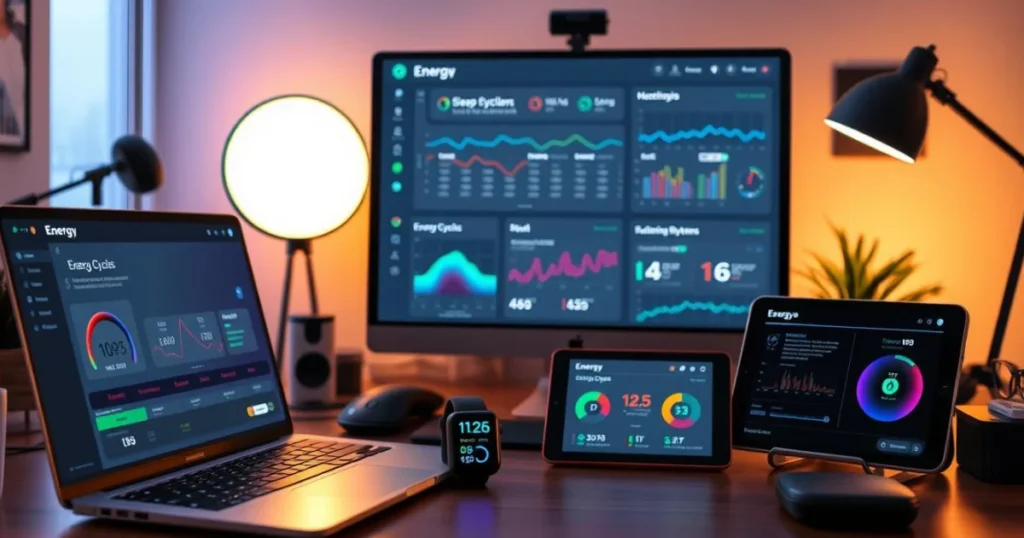Managing Fatigue: Essential Tips to Restore Your Energy”
Imagine hitting midday and feeling your energy drop. Coffee might give you a temporary boost, but the tiredness comes back. You’re not alone in this struggle. Millions of people are caught in a cycle of fatigue, trying to balance work, family, and self-care.
Exhaustion isn’t just about feeling tired. It’s a barrier to the life you dream of. Imagine breaking away from it?
This guide isn’t a quick fix. It’s your roadmap to lasting change. We’ll explore why fatigue happens and how small changes can help you overcome it for good.

Table of Contents
Understanding Fatigue: More Than Just Being Tired
Feeling tired isn’t just about not sleeping enough. Fatigue often comes from hidden causes in your body. Knowing these can help you manage fatigue and reduce fatigue symptoms. Let’s explore it further.
Distinguishing Between Different Types of Fatigue
| Type | Cause | Symptoms | Impact |
|---|---|---|---|
| Physical | Overexertion, poor diet | Muscle weakness, slow reflexes | Weakens physical tasks |
| Mental | Stress, lack of focus | Foggy thinking, forgetfulness | Hurts work and relationships |
| Emotional | Emotional strain | Irritability, sadness | Affects mood and motivation |
How Fatigue Impacts Daily Performance
- Cognitive effects: Slower problem-solving and memory lapses
- Emotional effects: Mood swings and reduced patience
- Physical effects: Weaker stamina and coordination
Knowing these patterns is crucial for managing fatigue. Small changes can make a big difference!
Common Causes of Chronic Fatigue in Modern Life
Hidden energy drains in everyday life sap wellness. Many become exhausted by these daily factors:
- Screen time before bed: Blue light from phones delays melatonin, making fatigue management harder.
- Shift work and late-night scrolling disrupt your body’s clock, making you fatigued.
- Poor nutrition: Diets heavy in processed foods lack iron and B12, key for energy production.
- Stress overload: Chronic pressure triggers prolonged cortisol spikes, draining reserves needed to combat tiredness.
| Factor | Energy Impact |
|---|---|
| Blue light exposure | Reduces melatonin, delaying deep sleep |
| Unbalanced diets | Weakens ATP production in cells |
| Sedentary jobs | Low muscle activity slows metabolic energy use |
| Stress hormones | Cortisol imbalances drain glucose stores |
Identifying these triggers helps tailor strategies to combat tiredness. Small changes like meal planning or screen breaks can reset your energy balance without overhauling your lifestyle.
The Mind-Body Connection: How Thoughts Affect Your Energy
All thoughts transmit waves through your body. Negative thoughts can drain your energy, while positive ones can boost it. Understanding this connection is crucial for better energy management and reduce fatigue symptoms.
Breaking the Cycle of Fatigue-Related Negative Thinking
Your body slows down when you say “I can’t keep going”. This creates a cycle of exhaustion. To break it, try:
- Changing “I’m too tired” to “I’ll feel better after moving”
- Challenging “I can’t” thoughts with evidence of past energy boosts
- Switching to action-oriented statements instead of focusing on fatigue
Mindfulness Techniques for Energy Conservation
Mindfulness is more than relaxation; it’s about saving energy. Here are some practices to try:
| Technique | Energy Impact |
|---|---|
| 3-Second Breath Focus | Quiets mental noise to conserve mental energy |
| Body Scan Meditation | Identifies physical tension draining energy reserves |
| 5-1-5 Grounding | Shifts focus from fatigue to present-moment awareness |
The Role of Stress in Perpetuating Exhaustion
Chronic stress leads to a big energy crisis. It raises cortisol, which messes with sleep, steals nutrients, and tightens muscles. This makes it hard to reduce fatigue symptoms:
Stress also messes with your decisions, leading to bad sleep choices and less resilience. Simple stress checks can stop this cycle before it drains your energy.
Nutrition Strategies for Managing Fatigue
Your diet is a powerful tool to boost energy levels and combat tiredness. By choosing the right foods, staying hydrated, and considering targeted supplements, you can fuel your body’s natural energy systems effectively.

Energy-Boosting Foods and Meal Timing
Eat meals that pair complex carbs with protein and healthy fats. These ingredients maintain energy and blood sugar. Try:
- Oatmeal topped with nuts and berries
- Grilled chicken with quinoa and steamed veggies
- Whole-grain toast with avocado and an egg
Eat every 3–4 hours to avoid energy dips. Overeating or skipping meals might upset your metabolism.
Hydration: The Overlooked Energy Factor
Sluggish metabolism results from even modest dehydration. Drink water in the morning and between meals. Add slices of citrus or cucumber for flavor without added sugar. Aim for 8–10 cups daily to combat tiredness and support focus.
Supplements That May Help Combat Tiredness
Consider supplements if diet alone isn’t enough. B-vitamins (found in leafy greens and fish) help convert food into energy. Foods high in iron, such as lentils and spinach, stop anemia-related tiredness. Magnesium and CoQ10 support cellular energy production. Consult a doctor before taking supplements.
Sleep Optimization: The Foundation of Fatigue Management
Quality sleep is key to fatigue management. Without it, even the best diets or workouts won’t help. Make your bedroom a place for rest. Start by controlling your sleep environment:
- A comfortable sleep temperature is 60–67°F (15–19°C).
- Block artificial light with blackout curtains—melatonin production depends on darkness.
- Reduce disruptive sounds with white noise devices or earplugs.
- Invest in a mattress and pillows rated for spinal alignment to avoid nighttime discomfort.
Keep a constant wake-up time, including on weekends. This helps keep your body’s clock in sync. Get natural light within an hour after waking. Your body adapts to the day.
Avoid coffee and alcohol after 2 PM and before bed. Both can hurt your sleep quality. For those who use tech, stop using screens an hour before bed. Blue light from electronics can disrupt sleep.
Every 90-minute sleep cycle helps your body recharge. Focus on this to naturally boost energy levels. Small modifications today can boost energy tomorrow.
Physical Activity: Why Movement Fights Exhaustion
Moving when you’re tired might seem hard, but it’s actually good for you. Even small movements can help overcome exhaustion. Exercise improves blood flow, strengthens muscles, and releases hormones that boost energy.
Low-Energy Exercise Options for Tired Days
Begin with small steps to avoid getting too tired. These activities help build stamina without pushing too hard:
| Exercise | Benefits | Time |
|---|---|---|
| Walking | Improves circulation and mental clarity | 20–30 minutes daily |
| Yoga | Reduces stress and enhances flexibility | 15–25 minutes |
| Swimming | Full-body workout with low joint strain | 30 minutes 3x weekly |
Building an Exercise Routine That Boosts Energy
Effective energy management begins with routines that fit your energy levels. Here’s how to start:
- Start with 10-minute sessions and build up.
- Alternate active days with rest to avoid exhaustion.
- Use a fitness app like MyFitnessPal or Strava to track your progress.
The Science of Exercise-Induced Energy Enhancement
Exercise makes your cells produce more energy. It increases blood flow, oxygenating muscles and the brain. Studies prove regular activity increases adrenaline and endorphins, leading to natural energy boosts. Concentrate on consistency rather than quantity.
Work-Life Balance: Prevent Burnout Before It Starts
Millions suffer from chronic workplace exhaustion, but many ignore early signs. To keep your energy up, set clear managing fatigue boundaries. Evaluate your daily routine for energy and depletion.
- Turn off work alerts after hours to define digital boundaries. Use apps like Freedom or Focus@Will to block distracting platforms during downtime.
- Delegate effectively: Learn to say no to non-essential tasks. Track delegated tasks without micromanaging with Asana or Trello.
- Create a post-work ritual: Take 10 minutes daily to mentally “close” work mode—try journaling or a short walk to signal transition to personal time.
Work and home must be clearly separated for remote workers. Create a specific work area and keep to your schedule. Use apps like RescueTime to spot overwork patterns.
Prevent burnout by doing regular energy audits. Keep a journal for a week to see what gives you energy and what drains it. Swap two draining tasks each week for activities that recharge you, like mindfulness breaks or chats with supportive colleagues.
Even small changes can make a big difference. By setting boundaries and managing your energy, you’ll thank yourself later.
Technological Solutions to Improve Alertness and Track Energy Patterns
Modern technology gives us tools to act on data. Wearables like the Fitbit Sense or Apple Watch Ultra track your heart rate and sleep. They indicate when to rest or exercise.
Apps like Headspace and Calm use your data to suggest breaks or mindfulness. They help manage fatigue with personalized tips.

Apps like AutoSleep help find the best wake-up times. The Philips goLITE adjusts your body clock with light. Here’s how to use them well:
- Track your activity with devices like Whoop Strap to find balance.
- Log your meals with MyFitnessPal to see how food affects your energy.
- Try Insight Timer for breathing exercises that lower stress and fatigue.
Behavioral apps like Habitica make energy-boosting routines fun. By linking devices, you learn what boosts alertness and what drains it. These technologies transform conjecture into scientifically supported methods for long-term energy and alertness improvements.
When to Seek Professional Help for Persistent Fatigue
See a doctor if simple modifications don’t work. Long-lasting tiredness could mean a serious health problem. Experts can help figure out what’s wrong.
Medical Conditions Linked to Chronic Fatigue
Many health problems can cause constant tiredness. Knowing these can help fight fatigue:
| Condition | Common Symptoms | Recommended Specialist |
|---|---|---|
| Thyroid Disorders | Unexplained weight changes, sensitivity to cold | Endocrinologist |
| Anemia | Paleness, rapid heartbeat, shortness of breath | Hematologist |
| Sleep Apnea | Daytime drowsiness, loud snoring | Sleep Medicine Specialist |
| Depression | Loss of interest, persistent sadness | Psychiatrist |
Finding the Right Specialist
- Contact your primary care physician for initial testing.
- Ask for blood work to check for anemia or thyroid imbalances.
- Suspect nightly restlessness? Get a sleep study.
- Discuss mental health screenings if emotional factors contribute.
Early diagnosis can lead to effective treatments. Don’t delay if weariness affects your life.
Conclusion: Your Personal Roadmap to Sustained Energy and Vitality
Your journey to lasting energy starts with making choices that fit you. Begin by looking at how you sleep, eat, and move. Small changes, like eating nuts instead of sweets or taking a short walk, can make a big difference.
Beat exhaustion by adding mindfulness breaks or breathing exercises to your day. Use tools like the WHOOP band or Headspace app to track your energy. This helps you alter your strategy.
Make changes that fit your life. If work keeps you up late, start with better sleep habits. Use apps like MyFitnessPal to improve your meal timing. Keep track of your progress with journals or wearables to see what works.
Don’t expect quick results. Building energy takes time and effort. Focus on balancing nutrition, rest, and mindfulness. Celebrate small wins to stay motivated.
Remember, lasting energy comes from consistent effort. Adapt your approach as life changes. Your energy is within reach through small, daily steps. Start today by improving your sleep or taking a break to stretch.
Disclaimer:
The content of this article is provided for informational and general purposes only. It does not constitute medical advice, diagnosis, or treatment. For any health-related concerns, please consult a qualified healthcare professional.
